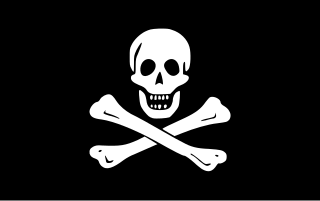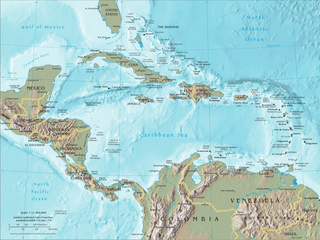
The attack on Veracruz was a 1683 raid against the port of Veracruz, in the Viceroyalty of New Spain (colonial Mexico). It was led by the Dutch pirates Laurens de Graaf, Nicholas van Hoorn and Michel de Grammont.

The attack on Veracruz was a 1683 raid against the port of Veracruz, in the Viceroyalty of New Spain (colonial Mexico). It was led by the Dutch pirates Laurens de Graaf, Nicholas van Hoorn and Michel de Grammont.
On 17 May 1683 the pirates arrived off the coast of Veracruz with a small fleet which included five large vessels, eight smaller vessels and around 1300 pirates. [1] At the head of the fleet sailed two Spanish warships, previously captured by van Hoorn, designed to confuse the townsfolk into thinking the fleet was Spanish. [2]
While the fleet was anchored offshore, de Graaf and Yankey Willems were landed some distance from the town and waited until early the following morning. While most of the town's militia were sleeping, the men disabled the town's fortifications and allowed van Hoorn and a large force of pirates, who had marched overland, to enter the city and neutralise the remaining defences. The pirates sacked the town and took many hostages including the town's governor. [3]
On the second day of plundering, the Spanish plate fleet, composed of numerous warships, appeared on the horizon. The pirates retreated with hostages to the nearby Isla de Sacrificios and waited for ransoms. Impatient that payments did not arrive immediately, Van Hoorn ordered the execution of a dozen prisoners and had their heads sent to Veracruz as a warning. De Graaf was furious; the two argued and then fought a duel. [4] Van Hoorn received a slash across the wrist and was returned to his ship in shackles. The wound soon turned gangrenous and Van Hoorn died shortly thereafter. [5] Finally, giving up on further plunder, the pirates departed, slipping past the Spanish without hindrance. [3]

Piracy is an act of robbery or criminal violence by ship or boat-borne attackers upon another ship or a coastal area, typically with the goal of stealing cargo and other valuable goods. Those who conduct acts of piracy are called pirates, while the dedicated ships that pirates use are called pirate ships. The earliest documented instances of piracy were in the 14th century BC, when the Sea Peoples, a group of ocean raiders, attacked the ships of the Aegean and Mediterranean civilizations. Narrow channels which funnel shipping into predictable routes have long created opportunities for piracy, as well as for privateering and commerce raiding. Historic examples include the waters of Gibraltar, the Strait of Malacca, Madagascar, the Gulf of Aden, and the English Channel, whose geographic structures facilitated pirate attacks. Privateering uses similar methods to piracy, but the captain acts under orders of the state authorizing the capture of merchant ships belonging to an enemy nation, making it a legitimate form of war-like activity by non-state actors. A land-based parallel is the ambushing of travelers by bandits and brigands in highways and mountain passes.

The era of piracy in the Caribbean began in the 1500s and phased out in the 1830s after the navies of the nations of Western Europe and North America with colonies in the Caribbean began combating pirates. The period during which pirates were most successful was from the 1660s to 1730s. Piracy flourished in the Caribbean because of the existence of pirate seaports such as Port Royal in Jamaica, Tortuga in Haiti, and Nassau in the Bahamas. Piracy in the Caribbean was part of a larger historical phenomenon of piracy, as it existed close to major trade and exploration routes in almost all the five oceans.

During the Spanish colonization of the Americas, the Spanish Main was the collective term for the parts of the Spanish Empire that were on the mainland of the Americas and had coastlines on the Caribbean Sea or Gulf of Mexico. The term was used to distinguish those regions from the numerous islands Spain controlled in the Caribbean, which were known as the Spanish West Indies.
This timeline of the history of piracy in the 1680s is a chronological list of key events involving pirates between 1680 and 1689.

Nicholas van Hoorn was a merchant sailor, privateer and pirate. He was born in the Netherlands and died near Veracruz after being wounded on the Isla de Sacrificios. Nikolaas or Klaas was engaged in the Dutch merchant service from about 1655 until 1659, and then bought a vessel with his savings. With a band of reckless men whom he had enlisted, he became a terror to the commerce of the Dutch Republic and the Spanish Empire. Later he had several ships in his employment and obtained such notoriety that some governments were willing to employ him against their enemies.

Michel de Grammont was a French privateer. He was born in Paris, Kingdom of France and was lost at sea in the north-east Caribbean, April 1686. His privateer career lasted from around 1670 to 1686 during which he commanded the flagship Hardi. He primarily attacked Spanish holdings in Maracaibo, Gibraltar, Trujillo, La Guaira, Puerto Cabello, Cumana and Veracruz.

Bartholomew Sharp was an English buccaneer and privateer. His career of piracy lasted seven years (1675–1682). In the Caribbean he took several ships, and raided the Gulf of Honduras and Portobelo. He took command of an expedition into the Pacific and spent months raiding settlements on the Pacific Coast of South America including La Serena which he torched in 1680. His flagship, taken at Panama, was the Trinity.
Henry Jennings was an 18th-century English privateer from the colony of Bermuda, who served primarily during the War of the Spanish Succession and later served as leader of the pirate haven or "republic" of New Providence.

Laurens Cornelis Boudewijn de Graaf was a Dutch pirate, mercenary, and naval officer in the service of the French colony of Saint-Domingue during the late 17th and early 18th century.
Captain John Coxon, sometimes referred to as John Coxen, was a late-seventeenth-century buccaneer who terrorized the Spanish Main. Coxon was one of the most famous of the Brethren of the Coast, a loose consortium of pirates and privateers. Coxon lived during the Buccaneering Age of Piracy.
Jan Willems, also known as Janke or Yankey Willems, was a 17th-century Dutch buccaneer. Based out of Petit-Goâve, Willems participated in a number of expeditions against the Spanish during the early to mid-1680s with other well-known privateers including Michiel Andrieszoon, Thomas Paine, Laurens de Graaf, Nicholas van Hoorn and Michel de Grammont.

Isla de Sacrificios is an island in the Gulf of Mexico, situated off the Gulf coastline near the port of Veracruz, in Mexico. The waters surrounding the island are part of the Sistema Arrecifal Veracruzano National Marine Park. It is currently closed to the public and is under the protection of the Secretariat of the Navy.
Michiel Andrieszoon was a Dutch buccaneer who served as lieutenant to Captain Laurens de Graaf. He commanded the le Tigre, with a 300-man crew and between 30 and 36 guns. He is occasionally referred to in English as Michel or Mitchell, and is often erroneously given the nickname "Bréha Michiel".

The raid on Cartagena was the successful counter-attack against vessels sent to defend the city of Cartagena de Indias and the subsequent blockade of the city by Laurens de Graaf and his pirate compatriots.

The Sack of Campeche was a 1663 raid by pirates led by Christopher Myngs and Edward Mansvelt which became a model for later coastal pirate raids of the buccaneering era.
Francois Le Sage was a pirate and buccaneer active in the Caribbean and off the coast of Africa. He is primarily associated with fellow buccaneers Michiel Andrieszoon and Laurens de Graaf.
Jacob Hall was an English buccaneer and pirate best known for joining a large Dutch and French attack on Spanish Veracruz.
George Spurre was an English pirate and buccaneer. He is best known for sacking Campeche and for joining a large buccaneer force which captured Veracruz.

Juan Corso was a Corsican pirate and guarda costa privateer who sailed in Spanish service, operating out of Cuba.
Jean Tristan was a French corsair (buccaneer) and pirate active in the Caribbean and against Spanish holdings in Central and South America.